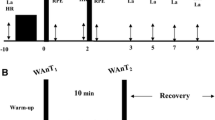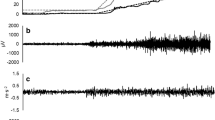Abstract
The relationships between absolute peak muscle power (W peak), muscle cross sectional area (CSAtot, i.e. the sum of both thigh and calf CSA) and muscle high energy phosphate concentration (adenosine 5′-triphosphate [ATP] and phosphocreatine concentrations [PC]) were studied in 47 subjects classified into five groups: A, 10 sedentary (S) subjects aged 20–35 years; B, 9 S aged 35–50 years; C, 9 S aged more than 50 years; D, 13 children aged 8–13 years; and E, 6 athletes (top level volleyball players) aged 24 (SD 3) years. The W peak was measured during a maximal vertical high jump off both feet on a force platform. The CSAtot was measured anthropometrically. The [ATP] and [PC] were determined by 31Phosphorus nuclear magnetic resonance spectroscopy. The W peak decreased with age, was 65% lower in D than in A, and 43% higher in E than in A. The CSAtot did not vary with age, was 45% smaller in D than in A, and 15% greater in E than in A. The [ATP] and [PC] were essentially the same in all groups. The changes observed in W peak were only partially accounted for by changes in CSAtot. Therefore, in addition to the variables investigated, other factors appear to have been involved in the determination of W peak with increasing age and training. An important role may be played by hormonal, particularly at puberty, and neural factors.
Similar content being viewed by others
References
Aniansson A, Hedberg M, Henning GB, Grimby G (1986) Muscle morphology, enzymatic activity, and muscle strength in elderly men: a follow-up study. Muscle Nerve 9:585–591
Bäckmann E, Henriksson KG (1988) Skeletal muscle characteristics in children 9–15 years old: force, relaxation rate and contraction time. Clin Physiol 8:521–527
Belanger AY, McComas AJ (1989) Contractile properties of human skeletal muscle in childhood and adolescence. Eur J Appl Physiol 58:563–567
Bell RD, McDougall JD, Billeter R, Howald H (1980) Muscle fiber types and morphometric analysis of skeletal muscle in six year old children. Med Sci Sports Exerc 12:28–31
Campbell MJ, McComas AJ, Petito F (1973) Physiological changes in ageing muscles. J Neurol Neurosurg Psychiatry 36:174–182
Cerretelli P, Mognoni P, Marconi C (1982) Aerobic and anaerobic metabolism in health and disease: the role of training. Ann Clin Res 14 [Suppl 34]:12–19
Davies CTM, Rennie R (1968) Human power output. Nature 217:770–771
Davies CTM, Barnes C, Godfrey S (1972) Body composition and maximal exercise performance in children. Hum Biol 44:195–214
Davies CTM, White MJ, Young K (1983) Electrically-evoked and voluntary maximal isometric tension in relation to dynamic muscle performance in elderly male subjects, aged 69 years. Eur J Appl Physiol 51:37–43
Decorps M, Blondet P, Reutenauer H, Albrand JP, Remy C (1985) An inductively coupled, series-tuned probe. J Magn Reson 65:100–109
Ferretti G, Gussoni M, Di Prampero PE, Cerretelli P (1987) Effects of exercise on maximal instantaneous muscular power of humans. J Appl Physiol 62:2288–2294
Ferretti G, Hauser H, Di Prampero PE (1990) Maximal muscular power before and after exposure to chronic hypoxia. Int J Sports Med 11 [Suppl 1]:S31-S34
Ferretti G, Ishii M, Moia C, Cerretelli P (1992) Effects of temperature on the maximal instantaneous muscle power of humans. Eur J Appl Physiol 64:112–116
Gariod L, Ferretti G, Binzoni T, Le Bas JF, Reutenauer H, Cerretelli P (1994) Normalization of high energy phosphate determinations by 31Phosphorus-nuclear magnetic resonance spectroscopy in humans. Eur J Appl Physiol (in press)
Glenmark B, Hedberg G, Jansson E (1992) Changes in muscle fiber type from adolescence to adulthood in women and men. Acta Physiol Scand 146:251–259
Grassi B, Cerretelli P, Narici MV, Marconi C (1991) Peak anaerobic power in master athletes. Eur J Appl Physiol 62:394–399
Häggmark T, Jansson E, Eriksson E (1981) Fiber type area and metabolic potential of thigh muscle in man after knee surgery and immobilization. Int J Sports Med 2:12–17
Ikai M, Fukunaga T (1968) Calculation of muscle strength per unit cross-sectional area of human muscle by means of ultrasonic measurements. Int Z Angew Physiol 26:26–29
Krotkiewski M, Kral JG, Karlsson J (1980) Effects of castration and testosterone substitution on body composition and muscle metabolism in rats. Acta Physiol Scand 109:233–237
Larsson L (1978) Morphological and functional characteristics of the ageing skeletal muscle in man. A cross-sectional study. Acta Physiol Scand 104:1–36
Larsson L (1982) Aging in mammalian muscle. In: Mortimer JA, Pirozzolo FJ, Maletta GJ (eds) The aging motor system. Advances in neurogerontology. Praeger Publisher Division, Greenwood Press, Westport, Conn., pp 60–97
Mercier B, Mercier J, Granier P, Le Gallais D, Préfaut C (1992) Maximal anaerobic power: relationship to anthropometric characteristics during growth. Int J Sport Med 13:21–26
Milner-Brown HS, Stein RB, Yemm R (1973) The orderly recruitment of human motor units during voluntary isometric contractions. J Physiol 230:359–370
Moritani T, Oddsson L, Thorstensson A, Åstrand PO (1989) Neural and biochemical differences between men and young boys during a variety of motor tasks. Acta Physiol Scand 137:347–355
Narici MV, Roi GS (1992) Relationship between muscle plus bone cross sectional area determined by anthropometry and nuclear magnetic resonance imaging (abstract). Pflügers Arch 420: R180
Narici MV, Bordini M, Cerretelli P (1991) Effect of aging on human adductor pollicis muscle function. J Appl Physiol 71:1277–1281
Narici MV, Landoni L, Minetti AE (1992) Human knee extensor muscle stress assessment from in-vivo physiological cross-sectional area and strength measurements. Eur J Appl Physiol 65:438–444
Saltin B, Gollnick PD (1983) Skeletal muscle adaptability: significance for metabolism and performance. In: Peachey LO, Adrian RH, Geiger SR (eds) Handbook of physiology. Skeletal muscle. American Physiological Society, Bethesda, Md., pp 555–631
Thorstensson A, Sjodin B, Karlsson J (1975) Enzyme activities and muscle strength after sprint training in man. Acta Physiol Scand 94:313–318
Ullman M, Alameddine H, Skottner A, Oldfors A (1989) Effects of growth hormone on skeletal muscle. 1. Studies on normal adult rats. Acta Physiol Scand 135:531–536
Viitasalo, Komi (1978) Force-time characteristics and fibre composition in human leg extensor muscles. Eur J Appl Physiol 40:7–15
Young A, Stokes M, Crowe M (1985) The size and strength of the quadriceps muscle of old and young men. Clin Physiol (Oxford) 5:145–154
Author information
Authors and Affiliations
Rights and permissions
About this article
Cite this article
Ferretti, G., Narici, M.V., Binzoni, T. et al. Determinants of peak muscle power: effects of age and physical conditioning. Europ. J. Appl. Physiol. 68, 111–115 (1994). https://doi.org/10.1007/BF00244022
Accepted:
Issue Date:
DOI: https://doi.org/10.1007/BF00244022




